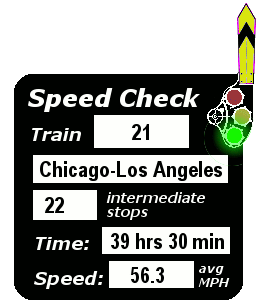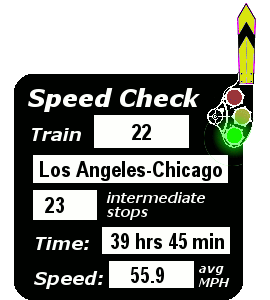CHICAGO,
KANSAS CITY AND CALIFORNIA.
EL CAPITAN.
EQUIPMENT
Completely Air-Conditioned.
EL CAPITAN.
Trains 21 and 22. (Until Mid-July.)
Chicago, Kansas City, Albuquerque and Los Angeles.
All-chair-car streamliner service.
Courier-Nurse Service. Radio and recorded musical programs.
Indian Guide on westbound El Capitan between Raton and Gallup, N.M.
(All Seats Reserved.)
Baggage Car...Chicago and Los Angeles.
Chair Car...Chicago and Los Angeles (44
reclining seats). Three cars.
Big Dome Lounge Car...Chicago and Los
Angeles.
Lunch-Counter Diners (2)...Chicago and Los
Angeles. Serving all meals. (Fred Harvey Service.)
Breakfast
80c and $1.10. Luncheon and Dinner a la carte.
Also
a la carte service for all meals.
Chair Car...Chicago and Los Angeles (44
reclining seats). Four cars.
Chair Observation Car...Chicago and Los
Angeles (42 reclining seats.)
New
Hi-Level Streamlined El Capitan Equipment.
Effective Mid-July, 1956. Extra Fare.
Trains 21 and 22.
Chicago, Kansas City, Albuquerque and Los Angeles.
All-chair-car streamliner service.
Courier-Nurse Service. Radio and recorded musical programs.
Indian Guide on westbound El Capitan between Raton and Gallup, N.M.
(All Seats Reserved.)
Baggage Dormitory Lounge Car...Chicago and
Los Angeles.
Hi-Level Chair Car...Chicago and Los
Angeles (68 seats). One car.
Chicago
and Los Angeles (72 seats). Two cars.
Hi-Level Dining Car...Chicago and Los
Angeles (80 seats). Serving all meals. (Fred Harvey Service.)
Breakfast
80c and $1.10. Luncheon and Dinner a la carte. Also a la carte service
for all meals.
Hi-Level Dome Lounge Car...Chicago and Los
Angeles (84 seats).
Hi-Level Chair Car...Chicago and Los
Angeles (72 seats). Three cars.
Chicago
and Los Angeles (68 seats). One car.
RULES
FOR EL CAPITAN, TRAINS 21 AND 22.
These trains will carry coach passengers between all regular scheduled
stops excepting locally in Arizona. Extra fare effective July 15.









By the mid-1950s El Capitan had become the most consistent year-round moneymaker for the Santa Fe; it was so popular it was often unable to meet the demand for reservations. In an effort to boost capacity; Santa Fe turned to Budd with a bold proposal, which became Santa Fe's trademark Hi-Level coaches. While bilevel designs had been in service in local commuter operations for several years, this represented the first application of the double-deck design to a through long-distance train. The new equipment featured baggage storage and large restrooms on the lower level, while the upper levels were entirely devoted to seating. (Unlike today's Amtrak Superliners, there was no seating area on the lower level and the restrooms were not unisex. Handicapped passengers had to negotiate the stairs at least once coming and going, although once they were upstairs they were seated in a special reserved section adjacent to the lounge car, which had upper level restrooms available.) A nine-car train of the new equipment seated 496 passengers, up from 350 for the single-level train, while the diner could serve 80 passengers at a sitting with a much roomier downstairs kitchen for the crew to work in.
This timetable, from July of 1956, shows the transition from the old to the new. The new Hi-Level El Capitan entered service on July 8 of that year, and effective as of its introduction, El Capitan's extra-fare status (which had lapsed a couple of years previously) was restored.
Read the feature article from the July 9, 1956 issue of Railway Age (PDF format, 1.5 MB [new, smaller scan])